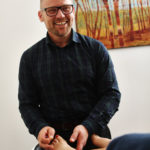Chronic pain in can present in many different areas and with varying intensity. Chronic pain, usually present for a number of months, is often the result a specific injury, such as:
different areas and with varying intensity. Chronic pain, usually present for a number of months, is often the result a specific injury, such as:
- lower back muscle strain or disc damage
- arthritis
- sciatic pain
- nerve impingement
But it also might happen because of a treatment or procedure. An example of this is chemo therapy or radiation therapy; as a side a affect it can cause peripheral neuropathy (needle-like pa in in experienced in the hands and feet).
But much of the chronic pain people experience in the clinic is idiopathic, meaning it has no obvious cause. This seems like an endless list, some examples are;
-
- Migraines
- Jaw pain (TMJ)
- Neck ache
- Abdominal ache
- Period pain
Acupuncture approach to chronic pain
Pain, from an acupuncture perspective is what we call blood stagnation. Essentially free flowing oxygenated blood around the body represents good health. The reasons as to why blood may block or stagnate include;
-
-
-
- stress,
- physical trauma or injury
- poor nutrition
- environment
-
-
The causes of pain may seem quite random, but when addressing the body holistically, a clearer picture can form. An acupuncturist will use diagnostics tools such as; looking at the tongue, feeling the pulse, palpating an area and chatting about the nature of the pain.
Can acupuncture help?
Currently evidence suggests acupuncture can help with some conditions of chronic pain. Please see our current evident page. This will involve a number of acupuncture sessions within a short period of time, often daily or every second day for three to four treatments. Acupuncture may be applied locally to the pain area or, if pain is particularly intense, needling away from the site of pain will provide better results.
 An acupuncture technique called distal needling or the balancing method involves needling on the opposite side of the body to a problem area and choosing correlating body parts or meridians. This technique can be particularly effective at breaking a pain cycle. If the initial cluster of treatments provide pain relief, subsequent treatments can be suggested weekly or fortnightly and then on a needs basis. Once the pain has settled, it allows the focus to shift from pain management to pain prevention. This may involve Chinese herbal medicine, dietary changes and discussions based on stress management and dealing with fatigue and other debilitating conditions.
An acupuncture technique called distal needling or the balancing method involves needling on the opposite side of the body to a problem area and choosing correlating body parts or meridians. This technique can be particularly effective at breaking a pain cycle. If the initial cluster of treatments provide pain relief, subsequent treatments can be suggested weekly or fortnightly and then on a needs basis. Once the pain has settled, it allows the focus to shift from pain management to pain prevention. This may involve Chinese herbal medicine, dietary changes and discussions based on stress management and dealing with fatigue and other debilitating conditions.

 By
By 

